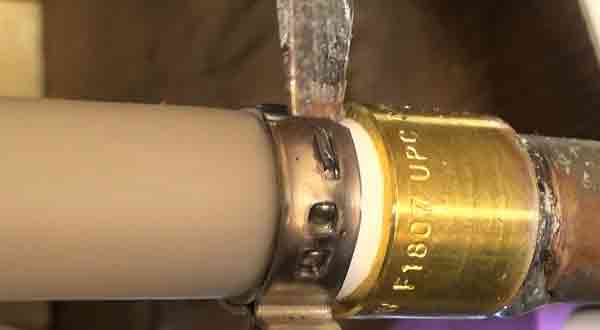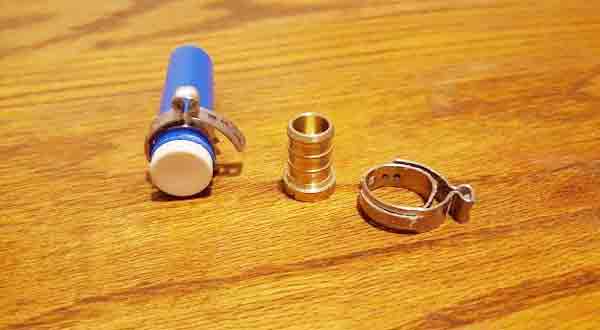Waterline clamps are small in RVs, inexpensive items that will help you make sure your plumbing system is in great shape for the long haul.
These clamps ensure that your pipes do not leak or burst. By replacing or removing them, you can maintain the integrity of your plumbing system and prevent any major problems from arising.
Waterline clamps in RVs are found on both hot and cold water lines and should be replaced yearly to keep them functioning properly.
The Following is How to Remove RV Water Line Clamps?

Step 1 - Clean the Parts
Start by taking your RV into a place that has running water and turn on both the hot and cold faucets to ensure there is enough pressure to fill the pipes. Let them run for about ten minutes before shutting the water off.
Step 2 - Disconnect Water Hoses from Fittings
Disconnect the water hoses from their respective PEX fitting. Do not remove any clamps yet, but do take note of their locations and how they are connected so that you can easily put them back on after removing the clamps.
Step 3 - Remove Clamp Covers
Loosen, but do not remove, the clamps and covers by turning the handles until they are loose enough to pull free from their locations on your water lines.
Step 4 - Remove Water Line Clamps
Loosen and remove your old, worn clamps and covers by sliding them up the hose. Replace or add a new pinch clamp before attaching the water hoses back into their fittings.
Step 5 - Check Water Line Plumbing
After you have finished, check your water lines plumbing to make sure it is connected properly and securely before turning your water back on at the faucets.
This should be done every time you service any part of your RV's plumbing to ensure that everything is working correctly and there are no leaks.
Step 6 - Turn Water On and Check Leaks
If you have checked your plumbing and it is still working well, turn the water back on at a faucet to fill up the hoses once more before opening all of them up again.
Check for any leaks or problems by looking for wet areas that could indicate where water is escaping from your RV's PEX tubing lines.
If you have found any problems, turn the water off and reevaluate where the problem might be coming from.
Remember to fix or replace anything that might need attention before reconnecting the hoses and starting up your water system again.
The Benefits of Replacing Your RV's Clamps

One of the benefits of replacing your RV's PEX tubing clamps is that you'll never have to worry about leaks in your plumbing system.
The clamps provide a secure connection for the piping that ensures there are no gaps and prevents the water from leaking.
Another benefit to replacing your RV's clamps is that they are cheap so you won't break the bank trying to replace them.
One of the major issues with clamps is that they can become brittle over time, which could cause a leak in your pipes.
Replacing them every couple of years will ensure that you don't have any issues with your plumbing system.
How to Know if a Water Line Needs Replacing?
You can replace your water lines clamps to fix hot water heater at any time, however, they should be checked and/or replaced every 2-3 years.
If you are having problems with leaky water heater lines in your RV, look for the cause of the leak to be the water line clamp.
Signs that it is time to replace your clamps include warped clamp, corrosion, or lose fittings. If you notice any of these things on your water lines, it may be time to replace the clamps!
Additional Tips for Replacing or Removing Water Line Clamps

Use a screwdriver to pry up the old PEX tubing clamp and a pair of pliers to pull it off. Be sure to use caution not to scratch or damage your pipes. If the clamp is going to be reused, inspect it thoroughly for rust and corrosion.
If your PEX pipe waterlines are in good condition but you wish to upgrade to a different size clamp, you can easily purchase replacements at any hardware store or RV parts shop.
It is very important that you get the right fit oversized clamps will not tighten correctly and undersized clamps won't offer enough protection.
The best way to make sure you are getting an appropriate replacement for a water heater line clamp is to take the original with you when purchasing a new one. If your old clamp has corroded badly, it may be wise to replace the entire hose.
You can replace the hose from the hose clamp easily if a soldering iron or propane torch is used to remove the connections. If your clamps are in good condition, they can simply be removed with pliers and reused on your new hose.
The correct size of the clamp for your water pump lines depends upon the type of material you have in your line (for example, copper or plastic) and the required pressure rating.
You will also need to know the size of your incoming water line and take into account the compression fittings that you have.
If you don't want to deal with any crimp ring, it might be wise to seek out a professional who is familiar with RV plumbing systems rather than trying to figure it all out yourself!
Conclusion
By following these steps, you can keep your plumbing system in great shape and prevent any major problems. If you do discover a problem, take your RV to a professional that specializes in campers or RVs for servicing rather than trying to repair it yourself.
Leave a Reply